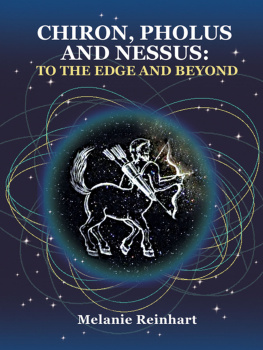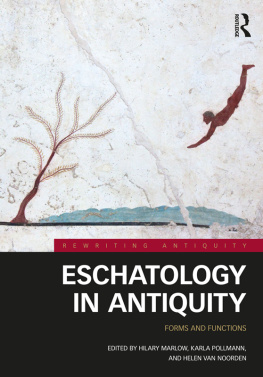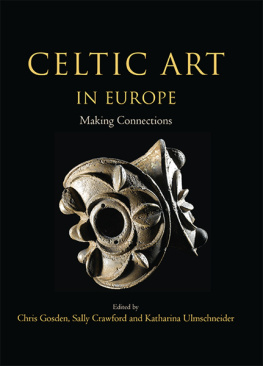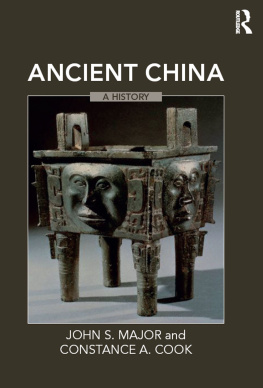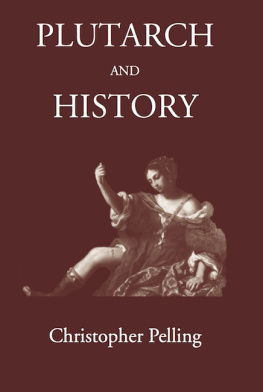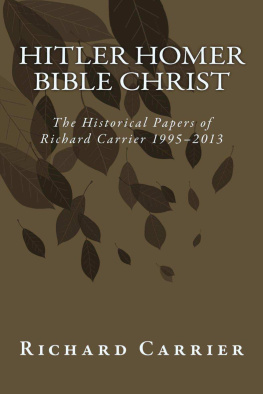INHALTSVERZEICHNIS
Guide

KOMMISSION FR ALTE GESCHICHTE UND EPIGRAPHIK
DES DEUTSCHEN ARCHOLOGISCHEN INSTITUTS
CHIRON 47 2017
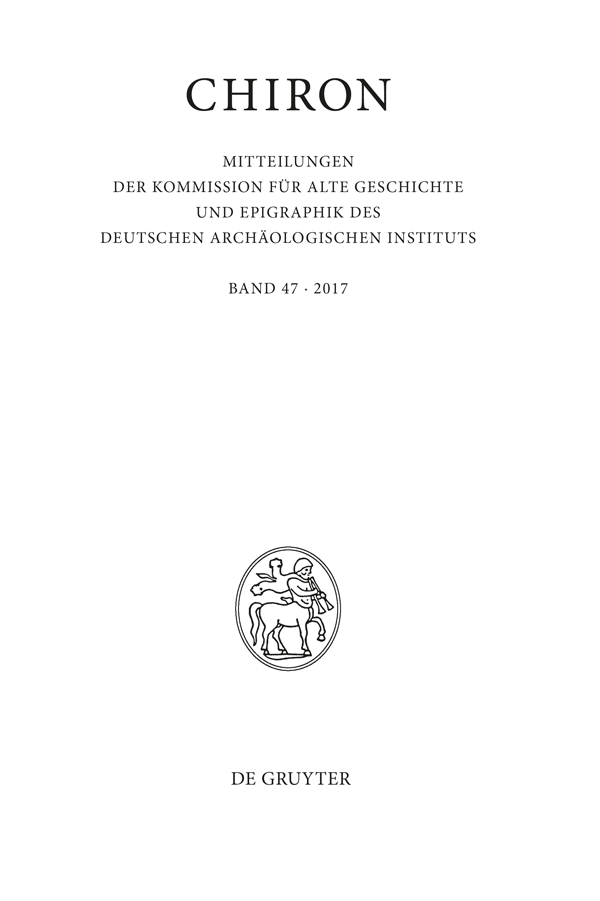
H ERAUSGEGEBEN V ON
C HRISTOF S CHULER , R UDOLF H AENSCH ,
S OPHIA B NISCH -M EYER
W ISSENSCHAFTLICHER B EIRAT
B RUNO B LECKMANN , A NNE K OLB , H ARTMUT L EPPIN , B ERNHARD P ALME ,
S EBASTIAN S CHMIDT -H OFNER , C LAUDIA T IERSCH , H ANS -U LRICH W IEMER ,
J OSEF W IESEHFER , C HRISTIAN W ITSCHEL , R EINHARD W OLTERS
ISSN 0069-3715
ISBN 978-3-11-056266-8
e-ISBN (PDF) 978-3-11-056698-7
e-ISBN (EPUB) 978-3-11-056520-1
Bibliografische Information der Deutschen Nationalbibliothek
Die Deutsche Nationalbibliothek verzeichnet diese Publikation in der Deutschen Nationalbibliografie; detaillierte bibliografische Daten sind im Internet ber http://dnb.dnb.de abrufbar.
2017 Walter de Gruyter GmbH, Berlin/Boston
www.degruyter.com
PAUL JARVIS
M. Peducaeus Plautius Quintillus:
Adoption, Marriage, and the Manipulation
of Imperial Propinquity
I am grateful to T. D. B ARNES, A. R. B IRLEY, G. K ELLY and the anonymous referees for their comments and criticisms. In addition, I should like to thank R. B URGESS, A. C OX and D. J AMES for their assistance. Unless otherwise indicated, all dates are CE. The citation of passages from Dio throughout follows the numbering of the Loeb edition of C ARY .
Marcus Aurelius married his daughter Lucilla to his adoptive brother and co-emperor, Lucius Verus. Among his other sons-in-law was Lucius nephew, M. Peducaeus Plautius Quintillus.
I. Family and connections
Peducaeus was born into an eminent family. On the side of his (natural) mother, Ceionia Fabia, he was the nephew of Lucius Verus and the grandson, great-grandson and great-great-grandson of consuls.
Peducaeus marriage to Fadilla meant that a nephew of Lucius by blood was marrying one of Lucius adopted nieces though Lucius was almost certainly dead when the Peducaeus himself was cos. ord . in 177 alongside Commodus, which surely provides a terminus ante quem for the marriage. Already a member of one side of the imperial family through his natural mothers family, his marriage to Fadilla emphasised the connection and brought him directly into the Antonine line.
II. Adoption by Peducaeus Stloga
That Peducaeus was adopted by M. Peducaeus Stloga Priscinus, cos. ord . 141, was first proposed by G ROAG on the basis of the complete nomenclature provided by a single inscription: M. Peducaeus Plautius Quintillus.
The accepted theory thus rests partially on the implicit assumption that Peducaeus was adopted in adulthood, as his abbreviated name remains identical to that of his natural father. Where his full name is exhibited the first nomen is that of his putative adoptive father, Peducaeus Stloga. However, since his natural fathers full name is unknown, this cannot be taken as proof of an adoption that applied specifically to Peducaeus.
It is still of course possible that he was adopted. Even if alternatives may be offered, evidence such as I.Ephesos 1423 cannot be dismissed without discussion. The supposed adoptive family of M. Peducaeus Plautius Quintillus still requires examination. The only possible adopter, Peducaeus Stloga, scion of an ancient Italian family that could show three consules ordinarii in successive generations, was scarcely less august than Peducaeus natural parents.
First, the age of Peducaeus himself should be considered. Making due allowance for the status of his natural father and possible adoptive father, his connections to the dynasty, and his own imperial marriage, his consulship was surely suo anno . It was in 177, alongside Commodus: so a date of birth c. 144. Another healthy son would be needed before one could be given in adoption. It is not difficult to suppose that Peducaeus Stloga found himself lacking an heir by c. 154, when he would probably be in his mid-forties at least.
The timing is important. Throughout the latter half of the 150s and 160s, the relations of Lucius were in the ascendant. Consulships were frequent and prestigious. was adopted by M. Peducaeus Stloga, who had been consul as far back as 141. Around 154 Peducaeus would be old enough and his parents may have had alternative heirs.
It is possible also to attempt to reconstruct the purpose of the adoption. The adoption of a relative was preferred where possible, but this was not a prerequisite. The ties of amicitia could also suffice, and constitute an arrangement beneficial to both parties: the adopter ensured the continuation of his line, and the adoptee would gain the patrimony of an allied family and could also retain his cognate rights. In this case, this would keep Peducaeus connected to the Ceionii through his mother.
By the putative date of the adoption of Peducaeus (c. 154), it was already clear that Marcus, not Lucius, was the favourite of Antoninus. Lucius was not given the title of Caesar, which was reserved for Marcus alone.
By the transfer of Peducaeus from the gens Plautia to the gens Peducaea a transition encouraged, enforced, or engineered by Antoninus and Marcus the imperial prospects of the Ceionii and their connections were to be reduced. Although in this reconstruction the adoption of the young Peducaeus would mean decreasing rather than increasing propinquity to the imperial family, one thing remains constant: the motivation of control. Such an adoption would leave Lucius with fewer potential male heirs, and the position of Marcus which Antoninus had enhanced and promoted at Lucius expense would be protected and secured. Different rules seem to have applied to Marcus own relations: it is likely that a son of Claudius Severus previous marriage to an Ummidia (before his marriage to a daughter of Marcus) was adopted by a maternal uncle, M. Ummidius Quadratus.
III. Plautius Quintillus, father of Peducaeus, was the adoptee
The second possibility is a variation on the accepted theory. Peducaeus Stloga, who remains the only known possible adopter, was cos. ord . in 141: eighteen years before Plautius Quintillus (159), and thirty-six years before Peducaeus (177). The first gap is significant, as it allows for either Plautius Quintillus or Peducaeus to be the adoptee. A large enough chronology remains for Plautius Quintillus to be the adoptee.
There is, however, a connected issue of nomenclature and chronology. The praenomen of L. Titius Plautius Aquilinus, Plautius Quintillus brother, is identical to that of their father, L. Epidius Titius Aquilinus. One might expect from this that he is the elder son, yet his consulship lags three years behind his brother. member of the ancient Italian gens Peducaea would in turn gain an heir. The fact that Plautius Quintillus, in his abbreviated nomenclature, continued to prefer a nomen that was his by birth that of his well-connected mother does not negate the possibility that it was he, not his son Peducaeus, who was adopted into the gens Peducaea .
IV. The nomen was inherited directly by Peducaeus
The third possibility is that the distinctive nomen Peducaeus was transferred to Peducaeus from his father Plautius Quintillus, and that there was no adoption in either generation. The full nomenclature of Peducaeus father is nowhere attested. An inscription provides Plautius Quintil[i]us during his consulship, but otherwise only Quintillus or Quintilius . The existence of the marriage (or even the more cautious conclusion of Chausson, a link between the families but no identifiable marriage) means that a connection between the nomen Peducaeus and the cognomen Quintillus precedes the son-in-law of Marcus.



